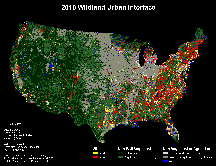On November 9, the White House hosted the Fire Chiefs' White House Roundtable: Climate Impacts on the Wildland Urban Interface (WUI). IAFC leaders joined about 40 fire chiefs at this summit, including:
- Chief Bill Metcalf, president 2013-2014
- Chief Norris Croom, international director, EMS Section
- Chief Erik Litzenberg, chair, Wildland Fire Policy Committee
- Chief Kim Zagaris, chair, Emergency Management Committee
- Chief Will May, National Wildfire Coordinating Group executive board
 We shared our thoughts with administration officials on how federal, state and local governments can best work together to mitigate the impact of wildland fire.
We shared our thoughts with administration officials on how federal, state and local governments can best work together to mitigate the impact of wildland fire.
Federal VIPs included Vice President Joe Biden, U.S. Fire Administrator Ernie Mitchell and FEMA Administrator Craig Fugate. Many of you know that Vice President Biden is a great friend to the fire service. He was a major player in passing legislation that enabled the creation of the first-ever public-safety broadband network (FirstNet), is a strong supporter of the SAFER and Fire Grants program and was instrumental in getting clarification on a provision in the Patient Protection and Affordable Care Act, which would have had an unintended negative impact on volunteer firefighters.
We’re grateful for the opportunity to speak to Vice President Biden on important wildland-fire issues facing communities across the United States as they become increasingly more dangerous and costly than ever before. We stressed that this has forced fire chiefs and firefighters to be smarter and more strategic in our approach.
It was an honor to share how in my department we continue to build our capacity to battle the ever-increasing threat of wildland fire through specialized wildland equipment and training. All uniform members of the Austin Fire Department are certified in wildland firefighting and the city has established the state’s first major municipal Wildfire Mitigation Division to help lead the charge in preparing for the next firestorm.
Other related issues of discussion included the 2012 Waldo Canyon Fire—which killed two people, burned 346 homes and forced the evacuation of thousands—and community resilience in the WUI. A big takeaway from our meeting is our need to change the mindset of the fire service that wildland fire is only a geographically western issue. The data and interactive maps we saw showed most fires are on the eastern seaboard near homes. This suggests that we need more comprehensive WUI and wildland-fire prevention strategies.
FEMA Director Fugate has been directed by President Obama to seek strategies to lessen the impact of climate change and its relationship to wildland fire. The next major wildfire isn’t a matter of if but when, so we must seek ways to minimize the impact, especially in vulnerable WUI communities in the Midwest, Northeast and Southeast. Ending drought and stopping wildland fire altogether aren’t realistic targets, so more communities must work on becoming fire-adapted communities; this is the best way to minimize risk to residents, property and our firefighters.
The IAFC is committed to working with FEMA and Fire Administrator Mitchell to do just that.
Fire Chief Rhoda Mae Kerr
President and Chair of the Board